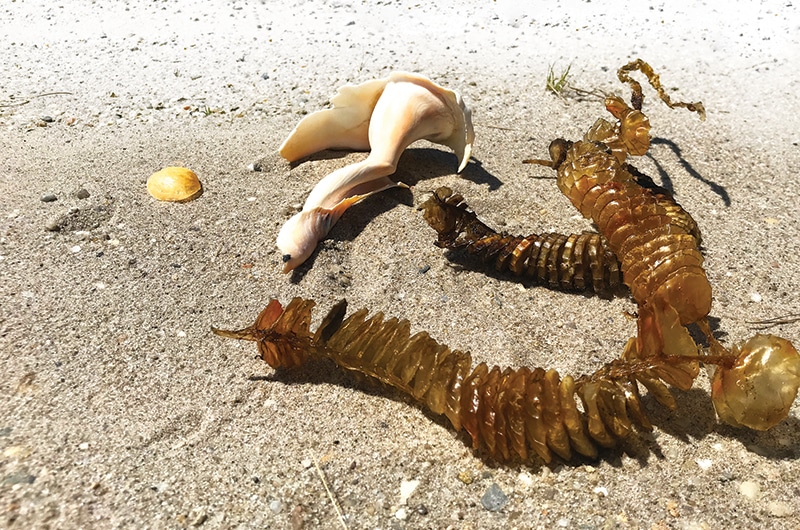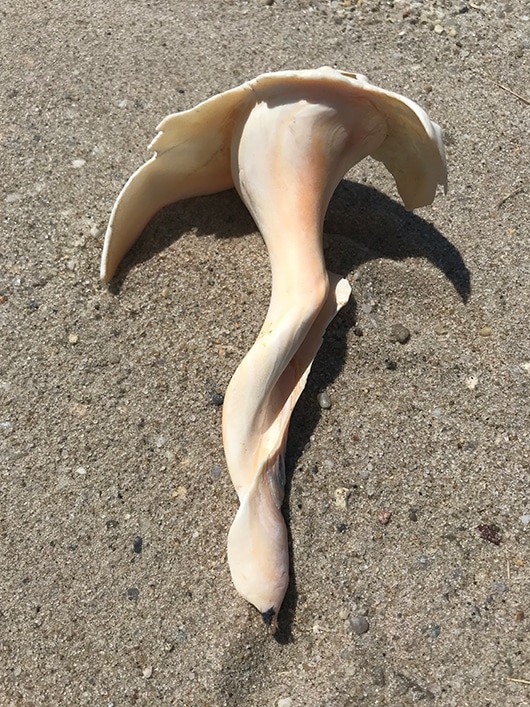by Dr. Sarah Treanor Bois
Director of Research & Education at the Linda Loring Nature Foundation
The recent hot July weather has made for some great beach going. Having a young child, I spend a lot of time on the north shore beaches, where the waves never get higher than five inches unless you count boat wakes. These beaches (Dionis, 40th Pole, Water Tower, and Steps, for example) are great for lazy beach walks and wonderful beachcombing.
Among the flotsam and jetsam of the beach wrack line, many treasures from the sea await. Searching for sea glass is ever popular. However, recycling and a heightened sense of litter, I find more of my son’s “sea glass” are actual shards rather than the smooth, cloudy sea glass of my childhood.

Beyond sea glass, the beach is littered with riches from the sea. Some are common, others rare, and most have some origin with a living thing. One thing is definitely true; none of it is boring! Even the most common of scallop shells have different patterns of growth and colors.
Here are some of my favorite beachcombing treasures found on Nantucket and a little bit about their origins.
Slipper Shell – The common slipper shell (Crepidula fornicata) is usually found in large numbers on the north shore of Nantucket. About two inches or less in size, they can be gray, white, or pink, or a combination. They are usually found stacked on top of each other when they wash ashore. When in a stack, the young on top are male, the bottom is female and the ones in the middle are hermaphrodites. The top males fertilize the slipper shell below and the sexes alternate back and forth to the bottom of the stack.
Sometimes called “Portuguese sweet meats,” slipper snails have been described as “poor man’s scallops.” To get at the meat, slide your finger underneath the muscle (foot) and pinch pulling towards the wider end to free it from the shell. Rinse it in the sea and you can eat it right on the beach to the delight of your fellow beach-goers.
Mermaid Toenails (aka jingle shells) – These are the small, often translucent shells that can be shiny yellow, white, or pale orange. The jingle shell (Anomia simplex) is a common intertidal species found attached to rocks, other mollusks and arthropods. It cannot move once it is attached to a substrate.
These are great for children since they are often found with a small hole and can be easily strung onto an impromptu beach necklace. The holes are actually where the valve of the animal was located, but was left attached to the substrate when the shell came off.
Sand Dollars – Instead of being a shell, the sand dollar (Echinarachnius parma) are disc-shaped animals in the sea urchin family that grow to about three inches in our area. Alive, they are brown and covered with velvety hair but when dead, they bleach to light gray or white in the sun and harden. They are closely related to sea stars and actually look like a sea star with no arms when alive. These are less common than the other species, but still found across Nantucket beaches.
Mermaid’s Purses – These rectangular horny “purses” are actually egg cases of the little skate (Raja erinacea), a relative of sharks and rays. They are the most common skate in northern inshore waters, thus, their egg cases are plentiful on the beach. The egg cases are made of keratin, the same substance of which human fingernails are composed. An egg case forms around each individual skate embryo just before the mother deposits the cases on the sea floor. The long, curved projections on each corner of the egg tend to catch on seaweed or other objects, helping to anchor the egg case to the bottom. The horns serve to extract oxygen from the water, and to release waste back into the water. The egg cases are very tough and hard to penetrate, thus deterring predators.

Interestingly enough, initially the egg cases are waterproof because the embryos do not have gills until after three weeks of development. Then small holes open in the tips of the horns, admitting seawater, and the young skate learns to live as an underwater creature. When the time comes for the young skate to escape, the egg case splits open at one end and the youngster emerges.
Whelk Shells – On the north or south shores you may find channeled or knobbed whelks (the knobbed, Busycon carica, is the most common on Nantucket). These sea snails resemble small conches but are actually a different species. This snail is carnivorous and will drill holes in other mollusk shells. Sometimes we also find the operculum of the whelk. The operculum is a 1-2-inch oblong structure that looks like a large, amber fingernail. It’s actually like the front door for the snail. When completely retracted inside its shell, the operculum fits into the opening, thus protecting the soft flesh of the snail from predators.
The inside of the whelk shell is smooth like porcelain and often has bright orange coloration. A young child I was walking with on the beach many years ago found the winding, center portion of the whelk shell. He held it up and exclaimed, “It looks like the twisty legs of a ballerina!” Indeed it does!

Whelk Egg Case – One of the most common beach finds among the eel grass and sea weed is actually the egg case for the whelk snail. The snakelike structures are difficult to figure out at first. What creature could have made this thing? The long egg case is made up of many chitinous egg cases. Each egg case (or capsule) holds numerous individual baby whelks. The shape of the capsule is specific to the type of whelk species, so you may be able to find more than one type. If the eggs haven’t hatched, you may be able to find some miniscule whelk shells inside that have dried up.
Moon Snail Shells – The northern moon snail (Lunitia heros) has a pink and gray shell with a light brown body. Like the whelk, it can retract completely and has an operculum to close its door. The empty shells often get used by flat-clawed hermit crabs, giving it an extra life. The females produce a “sand collar” which is a structure covered with sand where the snail lays her eggs. These are sometimes seen by snorkelers among the eel grass beds.
Moon snails are one of my personal favorites. They are more commonly found on the south shore of Nantucket, and I spent many a year looking for a “perfect” shell that wasn’t broken. When I did finally find one at Miacomet, I realized that is actually perfect because it was still alive. Holding the 4 inch snail in the palm of my hand for about 30 seconds, the smooth, cool flesh of the snail started to come out of its shell and covered my hand like a big wet kiss from the sea. I set it back in the sand and let the surf take it away.
Like most things from the beach, please leave what is alive. Only take a treasure or two, but leave the rest for all to enjoy.
You can see many of these creatures alive at the Maria Mitchell Aquarium located at 28 Washington Street (mariamitchell.org/visit/aquarium).


